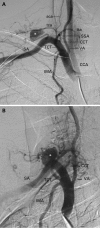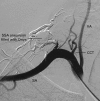Anomalous origin and aneurysm of the suprascapular artery: the first case observed
- PMID: 21686592
- PMCID: PMC3029979
- DOI: 10.1136/bcr.09.2008.0869
Anomalous origin and aneurysm of the suprascapular artery: the first case observed
Abstract
A 45-year-old woman was referred to our department having suddenly developed, 9 months earlier, a pulsating mass on the right supraclavicular fossa and torticollis. Colour Doppler sonography and computed tomographic angiography showed the presence of an aneurysm (21 mm in diameter) of the suprascapular artery that had an anomalous origin from the subclavian artery. Thoracic outlet syndrome was excluded. After selective arteriography, the aneurysm of the suprascapular artery was successfully treated with ethylene-vinyl alcohol polymer (Onyx, MicroTherapeutics, Irvine, California, USA), a liquid embolic agent. The patient was discharged on the first postoperative day in good condition. Control colour Doppler sonography at 1 year confirmed the complete thrombosis of the aneurysm sac.
Figures




Similar articles
-
Successful embolization of a suprascapular artery aneurysm.Ann Vasc Surg. 2014 Jan;28(1):261.e15-7. doi: 10.1016/j.avsg.2011.02.032. Epub 2011 May 28. Ann Vasc Surg. 2014. PMID: 21620668
-
Endovascular embolization of visceral artery aneurysms with ethylene-vinyl alcohol (Onyx): a case series.Cardiovasc Intervent Radiol. 2006 Nov-Dec;29(6):1125-8. doi: 10.1007/s00270-005-0148-3. Cardiovasc Intervent Radiol. 2006. PMID: 16625409
-
[Aneurysms of the subclavian artery].Srp Arh Celok Lek. 2000 May-Jun;128(5-6):184-90. Srp Arh Celok Lek. 2000. PMID: 11089419 Serbian.
-
[Arterial complications of thoracic outlet syndrome and pseudarthrosis of the clavicle: three patients].J Mal Vasc. 2003 Apr;28(2):79-84. J Mal Vasc. 2003. PMID: 12750638 Review. French.
-
[Surgical and interventional therapeutic possibilities in aneurysms of the subclavian artery].Zentralbl Chir. 2000;125(1):2-6. Zentralbl Chir. 2000. PMID: 10703160 Review. German.
Cited by
-
Delayed Presentation of a Post-traumatic Suprascapular Artery Pseudoaneurysm.Cureus. 2024 Mar 6;16(3):e55618. doi: 10.7759/cureus.55618. eCollection 2024 Mar. Cureus. 2024. PMID: 38586761 Free PMC article.
References
-
- Mintz S, Nelson EW. Delayed costocervical trunk aneurysm. J Trauma 1982; 22: 519–20 - PubMed
-
- Elariny HA, Crockett D, Hussey JL. False aneurysm of the thyrocervical trunk. South Med J 1996; 89: 519–21 - PubMed
-
- Garret HE, Heidepriem RW, Broadbent LP. Ruptured aneurysm of the inferior thyroid artery: repair with coil embolization. J Vasc Surg 2005; 42: 1226–9 - PubMed
-
- Diaz-Daza O, Arraiza FJ, Barkley JM, et al. Endovascular therapy of traumatic vascular lesions of the head and neck. Cardiovasc Intervent Radiol 2003; 26: 213–21 - PubMed
-
- Assali AR, Sdringola S, Moustapha A, et al. Endovascular repair of traumatic pseudoaneurysm by uncovered self-expandable stenting with or without transstent coiling of the cavity. Catheter Cardiovasc Interv 2001; 53: 253–8 - PubMed
LinkOut - more resources
Full Text Sources
